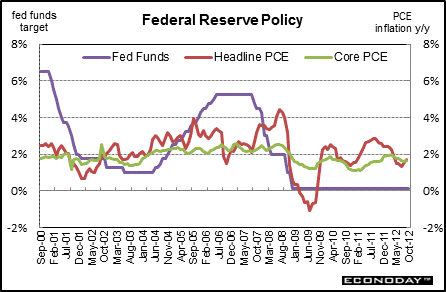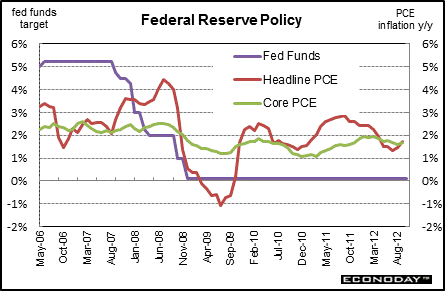| Production & Sales | Inflation | Federal Reserve Policy | Interest Rates |
FEDERAL RESERVE POLICY
Federal Reserve Policy |
|||
Long Term Perspective The real (inflation-adjusted) rate of interest (here, the fed funds rate relative to inflation) indicates the degree of constraint in the financial market and the real fed funds rate has swung sharply over the last ten years in a number of cyclical swings. In this case, the federal funds rate (controlled by the Fed) is compared to the yearly change in the core personal consumption expenditure price index, that is, the PCE price index excluding food and energy prices. A wide gap is evident in the late 1990s, and this points to relatively restrictive monetary policy, not an unusual occurrence during an economic expansion. When the core PCE price index and the fed funds rate were equal in 2002 and 2003, it signaled an accommodative policy stance. The gap widened in 2004 as the Fed tried to achieve a more neutral policy. The fed funds rate finally became higher than the inflation rate in 2005 after several the Fed raised rates several times in 2004 and 2005. The gap remained high in 2006 as the Fed continued to boost the fed funds target during the first half and held steady in the latter half and into 2007. The core PCE price index in the first half of 2007 began to respond to the Fed’s earlier tightening and by mid-2007 had eased into the upper portion of the Fed’s then believed implicit target range of 1-1/2 to 2 percent inflation.
In 2008, the Fed began releasing its economic forecast on a quarterly basis and with a three year forecast horizon. The latest forecast was released just before the chairman’s post-FOMC statement press conference for the September 12-13, 2012 FOMC meeting. Also, the Fed now includes a “longer run” forecast (five years or longer) that the FOMC participants believed is the sustainable number for each indicator. Starting with the January 2012 meeting the Fed officially established a 2 percent inflation goal for PCE inflation.
Short Term Perspective The current rate cutting cycle began on September 18, 2007, after the subprime crisis roiled the financial markets, with the Fed cutting the fed funds target rate from 5.25 percent in mid-2007 to a target range of zero to 0.25 percent, established December 16, 2008. Never before had the Fed set a publicly announced range for a target.
The Fed took this unprecedented measure of essentially taking the target to zero because the surge in liquidity since September 2008 pushed the effective fed funds rate to just above zero even though the target rate was notably above zero. With the December 15-16, 2008 meeting announcement the Fed stated that the fed funds rate likely would remain at those levels “for some time.”
Since the FOMC essentially cannot cut the fed funds rate any further, the Fed has focused on quantitative easing or credit easing. After cutting the fed funds target to a record low of a range of zero to 0.25 percent on December 16, 2008, the Fed really had no further room to cut and has left the target unchanged through the October 23-24, 2012 FOMC meeting. With recovery underway but sputtering, the Fed is concentrating on making sure that credit markets continue to improve and that the recovery is entrenched. With the September 12-13, 2012 FOMC meeting announcement, the Fed extended guidance on how long the fed funds rate likely will remain exceptionally low. This date was moved out to mid-2015, compared to prior guidance of through late 2014. That guidance remains.
Importantly, the Fed decided at the September 12-13, 2012 FOMC meeting to engage in a third round of quantitative easing. In contrast to the first two rounds, no end date was stated—the Fed will end quantitative easing according to views of economic conditions down the road. The Fed decided to focus on mortgage-backed securities for ramping up its balance sheet, planning to buy $40 billion per month. Operation Twist continues through then end of 2012. The Fed continues to reinvest pay down on mortgage-backed securities and agency debt to slow the natural unwinding of its balance sheet.
With recent numbers, headline inflation is somewhat below the Fed’s long-term inflation goal of 2 percent. This gives the Fed some room to continue easy monetary policy. The latest FOMC statement and some FedSpeak clearly indicate that the most members of the FOMC are more worried about high unemployment than inflation pressures. However, a vocal minority within the Fed have called into question whether additional quantitative easing will make much difference in economic growth and employment while at the same time boosting long-term risks for inflation.
|
|||

